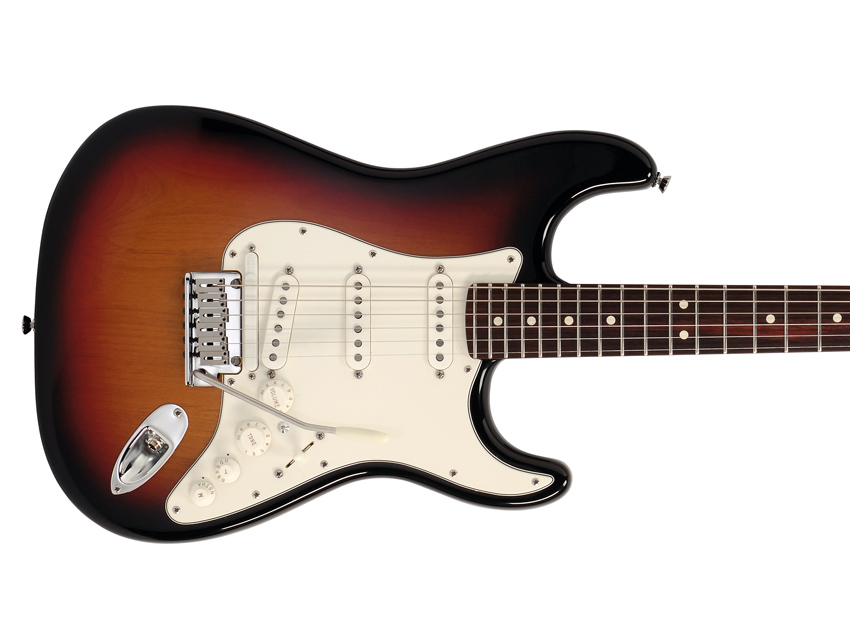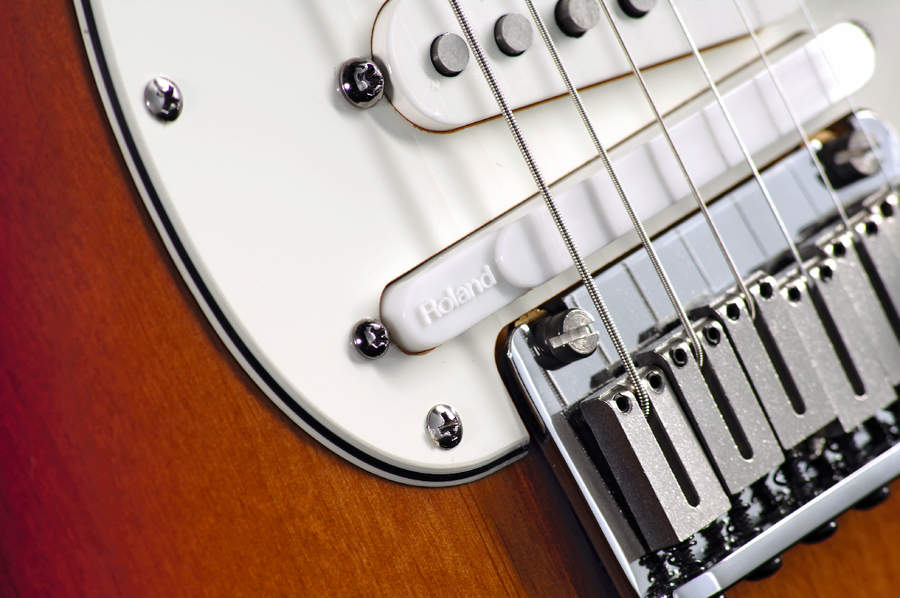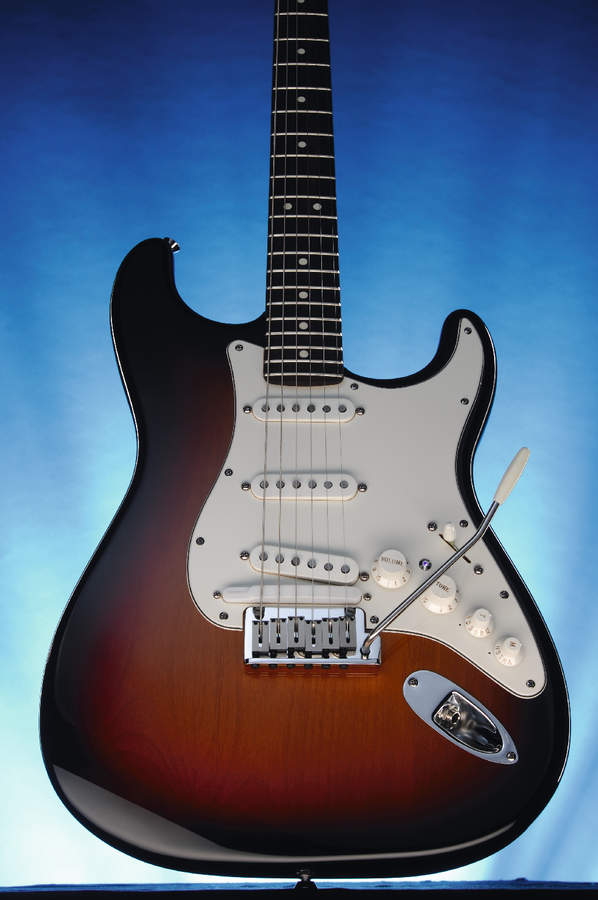MusicRadar Verdict
As a digital modelling guitar for the masses, Fender and Roland have got this pretty much spot on. Using the platform of the American Series Strat is perfect because it´s a pro spec guitar that´ll last. The VG side offers just enough of a glimpse of the potential benefits of digital modelling without any of the drawbacks.
Pros
- +
Simple to use digital modelling guitar with magnetic ‘back-up’; excellent tuning modes; looks just like a classic Strat!
Cons
- -
No phantom powering and short battery life; no custom setting.
MusicRadar's got your back

Fender VG Strat



The VG is unquestionably the most forward-looking Fender Stratocaster since the company launched the model in 1954. Yet aside from one extra knob and a sliver of discrete electronic augmentation in front of the bridge, it could be the same guitar that first appeared all those years ago. Fender - perhaps more than any other musical instrument company - knows that guitar players tend to like things just as they were.
Japanese electronics giant Roland - partnering Fender in this project - launched its first digital modelling guitar product, the VG-8, back in 1995. However, this innovative technology was a complex and expensive piece of kit.
Digital modelling became mainstream for guitarists largely because of Line 6. Slowly the company found its mark and the POD - the world's first 'desktop modeller' - revolutionised the way we recorded guitars.
Line 6 went further in 2002 and unveiled Variax: the world's first digital modelling guitar that recreated the sounds of numerous electric and acoustic instruments. Fast-forward to 2007 and Fender join the digital march with the VG Stratocaster.
In terms of the instrument itself, the VG is essentially an American Series Strat. The VG employs a two-piece alder body, with a maple neck and either rosewood or maple fingerboard. The neck's satin polyurethane finish is kept natural and looks a little anaemic, but the three-tone burst to the face of the guitar is rich and flawless, even if the back and sides here are all black.
We get generous fretwire, dual-height enclosed tuners and the two-post vibrato is distinctive with its large, rectangular, powdered stainless steel saddles. It's a good yet substantial weight, the set-up is immaculate, and details like the rolled fingerboard edges prove that Fender takes great care with its instruments.
Along with the three single-coils we get a Roland 'VG pickup' (basically Roland's GK divided pickup) close to the bridge. It's these two systems that are the heart of the guitar: the standard magnetic pickups allow the guitar to function as an 'analogue' Strat; the VG pickup takes care of digital modelling.
Instead of a second tone control, two smaller knobs control mode and tuning. The mode control starts with normal mode (indicated by N on the knob) in which the magnetic pickups are selected and the electronics function as normal, even when the batteries are spent.
The other four positions on the mode control are fed from the VG pickup and are modelled sounds. First up is modelled Stratocaster (S). Next is modelled Telecaster (T), the fourth position is humbucking pickups (H) - on these two settings the five-way acts like a three-way pickup selector switch so you get three sounds: bridge, both and neck. Finally acoustic (A) has five sounds simply referred to as Acoustic 1-5. On this setting the master tone acts as a reverb control.
Above this mode control is the tuning control. This is a six-position rotary selector that starts with normal (again N on the control legend) and doesn't affect the guitar. Then we get five selections that will alter the outputted tuning you hear when you're plugged in: drop D (DADGBE), open G (DGDGBE), D modal (DADGAD), Baritone B (BEADF#B) and 12-string.
Along with the usual vibrato back plate there is a larger cover plate on the back to hide the electronics and a flip-top battery compartment that takes four AA cells. With rechargeable batteries the life is quoted as 10 hours, and less with the non-rechargeable batteries supplied. It's not long and there's no provision for phantom power.
A bright blue LED lights up when you insert your jack lead and flashes when power gets dangerously low. There's just one output, so if you want to use both an electric and acoustic amp you'll need an additional 'Y' switcher box.
In use
The inclusion of standard magnetic pickups is both a plus and minus. We have not yet heard a digitally modelled guitar sound that, when compared to the 'real thing', is better. Very close, for sure, especially recorded and mixed into a track, but standing in front of your amp, at volume, is a different matter.
The American Series Strat sound veers towards a modern, bright and snappy tone but it's wonderfully dynamic and musical with that elusive funk and elasticity that makes the Stratocaster so alluring. Switching to the modelled Strat sounds loses a little sparkle and dynamics.
The Tele sounds are well matched, and although we only have three, few would argue that these aren't pretty definitive. The humbucking trio sound, as intended, more like a humbucker-equipped bolt-on than a classic Les Paul but the darker, fuller grunt easily achieves fatter distortion or smoother jazzier tones.
We'd describe the first three acoustic models as modern acoustic simulations; bright, but enough to provide a convincing acoustic bed live, or a rather synthetic modern part for recording. Vintage Martin they're not. The fourth setting is a dark and solid sound that has a little archtop-like character. The fifth sound is a plunky, banjo-like resonator.
The tuning mode is very good. Unlike Variax, which suffers a slight delay in outputting the detuned note, the VG's latency is unnoticeable. That's not to say it sounds 100 per cent true. The low-tuned baritone is a little unnatural, but select the Tele model, add a little slap-back to a clean Fender amp and it's instant Bakersfield country.
The 12-string sounds at extremes a little synthetic. But use it for chordal strumming and arpeggios and, again, it's convincing enough. DADGAD is a difficult tuning to master; open G and dropped D are easier and excellent sounding.
Don't forget the master tone acts as a reverb control for the acoustic models. When the tone is full on you have maximum, full-sounding reverb which can be muted with the tone fully anticlockwise. Just remember when you switch back to, say, the Strat models you'll have to pull your tone control back up.
Getting used to the extra knobs takes a little while, so switching sounds and tunings quickly in the heat of a performance requires some focused thought. There's a slight warbling when you change pickup selections, but to our ears, no intrusive hiss or noise. The modelled sounds are thankfully absent from pickup hum.
The VG Stratocaster should be user-upgradeable; we should have a choice of different modelled sounds and tunings that we could, for example, download and install to the VG. But are we getting ahead of ourselves? As it stands the VG Stratocaster joins Variax as another example of the technology that is shaping the future of the electric guitar. Bring it on.
With its latest free update, Ableton has finally turned Note into the app I always wanted it to be
Technically capable, but struggle to make your tunes sound musical? 5 simple music theory hacks to make your tracks stand out
"Despite its size, it delivers impressive audio quality and premium functions as well as featuring a good selection of inspired sounds": Roland GO:Piano 88PX review









